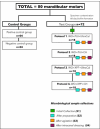Effect of Disinfection Protocols on Bacterial Reduction in Mandibular Molars
- PMID: 38935107
- PMCID: PMC11413596
- DOI: 10.14744/hnhj.2024.47450
Effect of Disinfection Protocols on Bacterial Reduction in Mandibular Molars
Abstract
Objective: Evaluate the bacterial reduction effect of disinfection protocols used in lower molars infected by Enterococcus faecalis.
Methods: Eighty extracted lower molars were prepared and inoculated with E. faecalis for 2 months. The teeth were then distributed into 2 control groups (n = 4) and 4 experimental groups (n = 18) in function of the disinfection protocol utilized: G1. WaveOne Gold (WOG), passive ultrasonic irrigation (PUI) and Ultracal; G2. WOG, PUI and calcium hydroxide (CH); G3. WOG, XP-Endo Finisher (XPF) and Ultracal; G4. WOG, XPF and CH. Bacteriological samples were collected previously (S1), after preparation (S2), final agitation (S3) and intracanal dressing (S4). Microbial growth was assessed according to culture turbidity and UV spectrophotometry. Statistical analyses used the Friedman test for paired samples and Kruskal-Wallis test for non-paired data (p<0.05).
Results: No protocol eliminated E. faecalis effectively. The S2, S3 and S4 samples were statistically different from the S1 samples in G1, G2, G3 and G4 (p<0.05). Statistical differences were observed in bacterial reduction between G1 and G2 and G1 and G3 after the intracanal medicament (S4) (p<0.05).
Conclusion: The WOG + PUI + CH disinfection protocol showed higher percentages of bacterial reduction.
Conflict of interest statement
All authors declared no conflict of interest.
Figures


References
-
- Estrela C, Holland R, Estrela CR, Alencar AH, Sousa-Neto MD, Pécora JD. Characterization of successful root canal treatment. Braz Dent J. 2014;25(1):3–11. - PubMed
-
- Nair PN, Henry S, Cano V, Vera J. Microbial status of apical root canal system of human mandibular first molars with primary apical periodontitis after "one-visit" endodontic treatment. Oral Surg Oral Med Oral Pathol Oral Radiol Endod. 2005;99(2):231–52. - PubMed
-
- Siqueira Junior JF, Rôças IDN, Marceliano-Alves MF, Pérez AR, Ricucci D. Unprepared root canal surface areas: causes, clinical implications, and therapeutic strategies. Braz Oral Res. 2018;32(Suppl 1):e65. - PubMed
MeSH terms
Substances
LinkOut - more resources
Full Text Sources
Medical
Molecular Biology Databases

